1998 GMC SIERRA tow
[x] Cancel search: towPage 14 of 452

Seats and Seat Controls
This section tells you about the seats -- how to adjust
them, and fold them up and down. It also tells you about
reclining front seatbacks and head restraints.
Manual Front Seat
I /! CAUTIO-.:
You can lose control of the vehicle if you try to
adjust a manual driver’s seat while the vehicle
is
moving. The sudden movement could startle and
confuse you, or make you push a pedal when you
don’t want to. Adjust the driver’s seat only when
the vehicle is
not moving.
If your vehicle has a manual
bucket, split bench or full
bench seat, you can adjust it
with
this lever at the front
of the seat.
Slide the lever at the front of
the seat toward the
passenger’s side to
unlock it. Using your body, slide the
seat to where
you want it. Then, release the lever and try
to move the seat with your body in order to make sure
the seat
is locked into place.
1-2
ProCarManuals.com
Page 15 of 452
Power Driver’s Seat (Option)
If your vehicle has a power seat on the driver’s side, you can
adjust
it with these controls at the outside edge of the seat.
You can use the round center knob to move
the seat to
where you want it.
To raise the seat, move the knob up.
To lower the seat, move the knob down. To move the
seat forward, move the knob toward
the front of the
vehicle, To move the seat rearward, move the knob
toward
the rear of the vehicle.
You can also raise and lower the front and rear
of the seat.
To raise the front of the seat, move the front lever up. To
lower the front of the seat, move the front lever down. To
raise the rear of the seat, move the rear lever up. To lower
the rear
of the seat. move the rear lever down. The switch located
at the front
of this control panel
is for the power lumbar adjustment, which is
explained next.
Power Lumbar Control (If Equipped)
If you have power lumbar
adjustment, you can
increase or decrease
lumbar support in an
area
of the lower seatback.
To increase support, press and hold the front of the
rocker switch. Let go of the switch when the lower
seatback reaches the desired level
of support.
To decrease support, press and hold the rear of the
rocker switch. Let
go of the switch when the lower
seatback reaches the desired level
of support.
1-3
ProCarManuals.com
Page 18 of 452
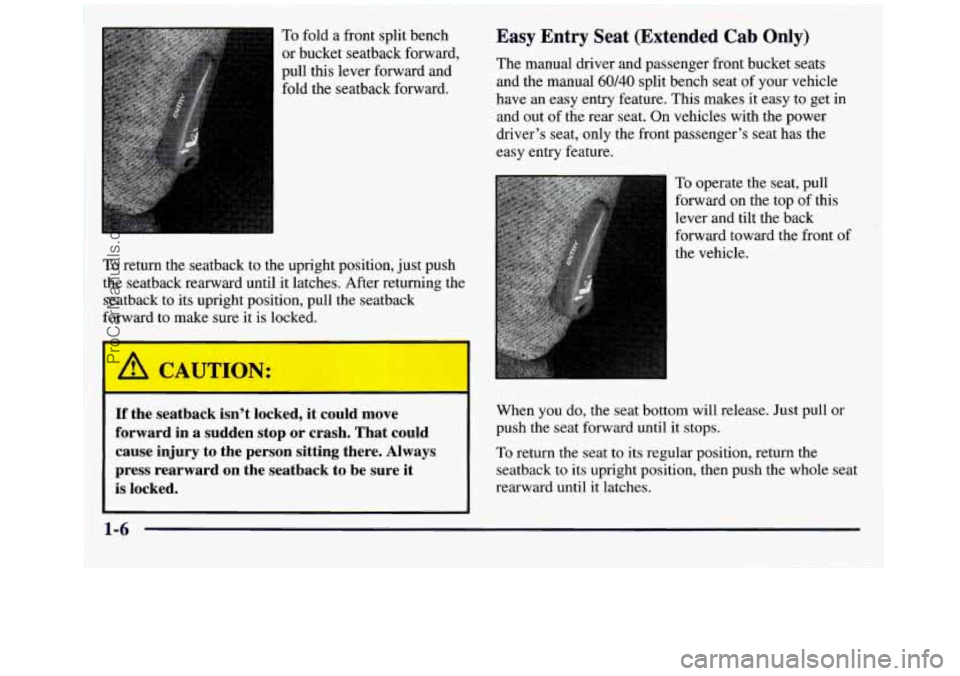
~ ~ ~~ ~~
~~ ~ ~~ To fold a front split bench
or bucket seatback forward,
pull this lever forward and
fold the seatback forward.
To return the seatback to the upright position, just push
the seatback rearward until it latches. After returning the
seatback to its upright position, pull the seatback
forward to make sure it is locked.
If the seatback isn’t locked, it could move
forward in
a sudden stop or crash. That could
cause injury to the person sitting there. Always
press rearward on the seatback to be sure
it
is locked.
Easy Entry Seat (Extended Cab Only)
The manual driver and passenger front bucket seats
and the manual
60/40 split bench seat of your vehicle
have an easy entry feature. This makes it easy to get in
and out of the rear seat. On vehicles with the power
driver’s seat, only the front passenger’s seat has the
easy entry feature.
To operate the seat, pull
forward on the top of this
lever and tilt the back
forward toward the front of
the vehicle.
When you do, the seat bottom will release. Just pull or
push the seat forward until it stops.
To return the seat to its regular position, return the
seatback to its upright position, then push the whole seat
rearward until it latches.
1-6
ProCarManuals.com
Page 40 of 452
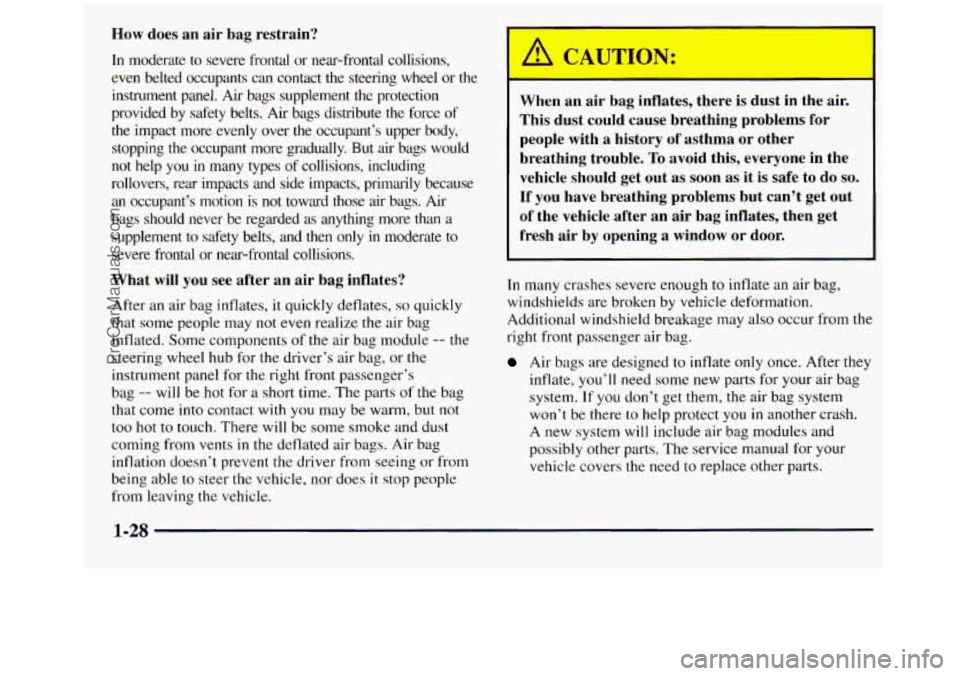
How does an air bag restrain?
In moderate to severe frontal or near-frontal collisions,
even belted occupants can contxt the steering wheel or the
instrument panel.
Air bags supplement the protection
provided by safety belts. Air bags distribute the force of
the impact more evenly over the occupant’s upper body,
stopping the occupant more gradually. But air bags would
not help you in many types of collisions, including
rollovers, rear impacts and side impacts, primarily because
an occupant’s motion is not toward those air bags. Air
bags should
never be regarded as anything more than a
supplement to safety belts, and then only
in moderate to
severe frontal or near-frontal collisions.
What will you see after an air bag inflates?
After an air bag inflates, it quickly deflates, so quickly
that some people may not even realize the air bag
inflated. Some components of the air bag module
-- the
steering wheel hub for the driver’s air bag, or
the
instrument panel for the right front passenger’s
bag
-- will be hot for a short time. The parts of the bag
that come into contact with
you may be warm, but not
too hot to touch. There will be some smoke and dust
coming from vents
in the deflated air bags. Air bag
inflation doesn’t prevent the driver from seeing or from
being able to steer
the vehicle, nor does it stop people
from leaving the vehicle.
When an air bag inflates, there is dust in the air.
This dust could cause breathing problems for
people with a history of asthma or other
breathing trouble,
To avoid this, everyone in the
vehicle should get out as soon as it
is safe to do so.
If you have breathing problems but can’t get out
of the vehicle after an air bag inflates, then get
fresh air by opening
a window or door.
In many crashes severe enough to inflate an air bag,
windshields are broken by vehicle deformation.
Additional windshield breakage may also occur from the
right front passenger air bag.
Air bags are designed to inflate only once. After they
inflate,
you’ll need some new parts for your air bag
system.
If you don’t get them, the air bag system
won’t be there to help protect you
in another crash.
A new system will include air bag modules and
possibly other parts. The service manual for your
vehicle covers the need to replace other parts.
ProCarManuals.com
Page 42 of 452

I NOTICE:
If you damage the covering for the driver’s or the
right front passenger’s air bag, the bag may not
work properly. You may have to replace the air
bag module in the steering wheel or both the air
bag module and the instrument panel for the right front passenger’s air bag.
Do not open or
break the air bag coverings.
Servicing Your Air Bag-Equipped Vehicle
Air bags affect how your vehicle should be serviced.
There are parts
of the air bag system in several places
around your vehicle. You don’t want the system to
inflate while someone is working on your vehicle. Your
dealer and the service manual have information about
servicing your vehicle and the air
bag system. To
purchase a service manual, see “Service and Owner
Publications”
in the Index.
If your vehicle ever gets into a lot of water -- such as
water up to the carpeting or higher -- or if water enters
your vehicle
and soaks the carpet, the air bag controller
can be soaked and ruined. If this ever happens, and then
you start your vehicle, the damage could make the air
bags inflate, even if there’s no crash.
You would have to
replace the air bags
as well as the sensors and related
parts. If your vehicle is ever
in a flood? or if it‘s exposed
to water that soaks the carpet, you can avoid needless
repair costs
by turning off the vehicle immediately.
Don’t
let anyone start the vehicle, even to tow it, unless
the battery cables are first disconnected.
I
For up to 10 minutes after the ignition key is
turned off and the battery is disconnected, an air
bag can still inflate during improper service. You
can be injured if you are close to an air bag when
it inflates. Avoid
wires wrapped with yellow tape
or yellow connectors. They are probably part of
the
air bag system. Be sure to follow proper
service procedures, and make sure the person
performing work for you
is qualified to do so.
~~
The ail- bag system does not need regular maintenance.
1-30
ProCarManuals.com
Page 57 of 452
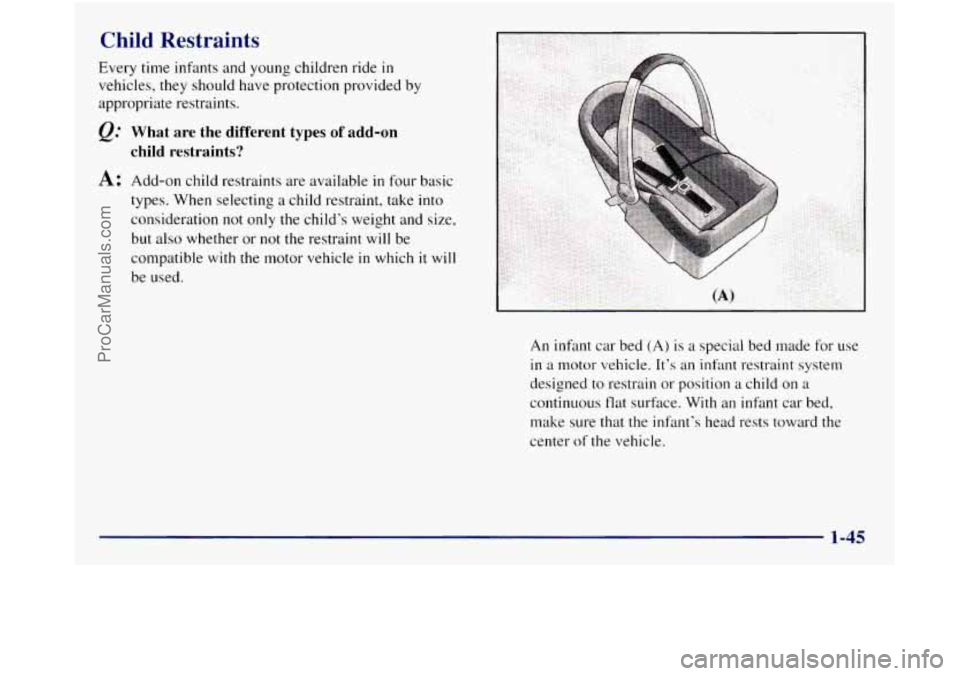
Child Restraints
Every time infants and young children ride in
vehicles, they should have protection provided by
appropriate restraints.
Q.’ What are the different types of add-on
child restraints?
A: Add-on child restraints are available in four basic
types. When selecting a child restraint, take into
consideration not
only the child’s weight and size,
but also whether or not the restraint will be
compatible
with the motor vehicle in which it will
be used.
An
inhnt car bed (A) is a special bed made for use
in a motor vehicle. It’s an infmt restraint system
designed to restrain
or position a child on a
continuous flat surface. With an
infmt car bed,
make sure that the infant’s head rests toward the
center of the vehicle.
1-45
ProCarManuals.com
Page 80 of 452
Never do this.
Here two children are wearing the same belt. The
belt can’t properly spread the impact forces. In
a
crash, the two children can be crushed together
and seriously injured.
A belt must be used by
only one person at a time.
What
if a child is wearing a lap-shoulder belt,
but the child is
so small that the shoulder belt is
very close to the child’s face
or neck?
A: Move the child toward the center of the vehicle, but
be sure that the shoulder belt
still is on the child’s
shoulder,
so that in a crash the child’s upper body
would have the restraint that belts provide.
If the
child
is sitting in a rear seat outside position, see
“Rear Safety Belt Comfort Guides”
in the Index.
If the child is so small that the shoulder belt is still
very close to the child’s face or neck, you might
want to place
the child in a seat that has a lap belt,
if your vehicle has one.
1-68
ProCarManuals.com
Page 87 of 452
Your vehicle has one
double-sided key for the
ignition and all door locks.
If you ever lose your keys, your dealer will be able to
assist you with obtaining new ones. Tailgate
You can open the tailgate by lifting up on its handle
while pulling the tailgate toward you.
To shut the tailgate, firmly push it away from you into
the latch.
After you put the tailgate back up, pull it back toward
you,
to be sure that it latches securely.
Tailgate Removal
The tailgate on your vehicle can be removed to allow for
different loading situations. Although the tailgate can be
removed without assistance, you may want someone to
assist you with the removal to avoid possible damage to
the vehicle.
NOTICE:
' Your vehicle has a number of new features that
can help prevent theft.
You can have a lot of
trouble getting into your vehicle if you ever lock
your key inside.
You may even have to damage
your vehicle to get in.
So be sure you have an
extra key.
~. _~- -- . ~. - ~
2-3
ProCarManuals.com